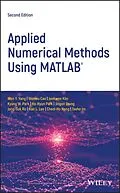This new edition provides an updated approach for students, engineers, and researchers to apply numerical methods for solving problems using MATLAB¯®
This accessible book makes use of MATLAB¯® software to teach the fundamental concepts for applying numerical methods to solve practical engineering and/or science problems. It presents programs in a complete form so that readers can run them instantly with no programming skill, allowing them to focus on understanding the mathematical manipulation process and making interpretations of the results.
Applied Numerical Methods Using MATLAB¯®, Second Edition begins with an introduction to MATLAB usage and computational errors, covering everything from input/output of data, to various kinds of computing errors, and on to parameter sharing and passing, and more. The system of linear equations is covered next, followed by a chapter on the interpolation by Lagrange polynomial. The next sections look at interpolation and curve fitting, nonlinear equations, numerical differentiation/integration, ordinary differential equations, and optimization. Numerous methods such as the Simpson, Euler, Heun, Runge-kutta, Golden Search, Nelder-Mead, and more are all covered in those chapters. The eighth chapter provides readers with matrices and Eigenvalues and Eigenvectors. The book finishes with a complete overview of differential equations.
* Provides examples and problems of solving electronic circuits and neural networks
* Includes new sections on adaptive filters, recursive least-squares estimation, Bairstow's method for a polynomial equation, and more
* Explains Mixed Integer Linear Programing (MILP) and DOA (Direction of Arrival) estimation with eigenvectors
* Aimed at students who do not like and/or do not have time to derive and prove mathematical results
Applied Numerical Methods Using MATLAB¯®, Second Edition is an excellent text for students who wish to develop their problem-solving capability without being involved in details about the MATLAB codes. It will also be useful to those who want to delve deeper into understanding underlying algorithms and equations.
Autorentext
Won Y. Yang, PhD, is a Professor in the Department of Electrical Engineering at Chung-Ang University in Seoul, Korea.
Wenwu Cao, PhD, is a Professor in the Department of Materials Science and Engineering at Penn State University in University Park, Pennsylvania.
Jaekwon Kim, PhD, is a Professor in the Department of Electrical Engineering at Yongsei University in Wonju, Korea.
Kyung W. Park, PhD, is a Professor in the Department of Electrical Engineering at Yonsei University, Wonju, Korea.
Ho-Hyun Park, PhD, is a Professor in the School of Electrical and Electronics Engineering at Chung-Ang University in Seoul, Korea.
Jingon Joung, PhD, is a Professor in the Department of Electrical Engineering at Chung-Ang University in Seoul, Korea.
Jong-Suk Ro is Creative Research Engineer Development at Brain Korea 21 Plus, Seoul National University in Seoul, Korea.
Han L. Lee, PhD, is a Professor in the Department of Electrical Engineering at Chung-Ang University in Seoul, Korea.
Cheol-Ho Hong is Assistant Professor in the School of Electrical and Electronics Engineering at Chung-Ang University in Seoul, Korea.
Taeho Im, PhD, is a Professor in Oceanic IT Engineering at Hoseo University in Asan, Korea.
Inhalt
Preface xv
Acknowledgments xvii
About the Companion Website xix
1 MATLAB Usage and Computational Errors 1
1.1 Basic Operations of MATLAB 2
1.1.1 Input/Output of Data from MATLAB Command Window 3
1.1.2 Input/Output of Data Through Files 3
1.1.3 Input/Output of Data Using Keyboard 5
1.1.4 Two-Dimensional (2D) Graphic Input/Output 6
1.1.5 Three Dimensional (3D) Graphic Output 12
1.1.6 Mathematical Functions 13
1.1.7 Operations on Vectors and Matrices 16
1.1.8 Random Number Generators 25
1.1.9 Flow Control 27
1.2 Computer Errors vs. Human Mistakes 31
1.2.1 IEEE 64-bit Floating-Point Number Representation 31
1.2.2 Various Kinds of Computing Errors 35
1.2.3 Absolute/Relative Computing Errors 37
1.2.4 Error Propagation 38
1.2.5 Tips for Avoiding Large Errors 39
1.3 Toward Good Program 42
1.3.1 Nested Computing for Computational Efficiency 42
1.3.2 Vector Operation vs. Loop Iteration 43
1.3.3 Iterative Routine vs. Recursive Routine 45
1.3.4 To Avoid Runtime Error 45
1.3.5 Parameter Sharing via GLOBAL Variables 49
1.3.6 Parameter Passing Through VARARGIN 50
1.3.7 Adaptive Input Argument List 51
Problems 52
2 System of Linear Equations 77
2.1 Solution for a System of Linear Equations 78
2.1.1 The Nonsingular Case (M = N) 78
2.1.2 The Underdetermined Case (M < N): Minimum-norm Solution 79
2.1.3 The Overdetermined Case (M > N): Least-squares Error Solution 82
2.1.4 Recursive Least-Squares Estimation (RLSE) 83
2.2 Solving a System of Linear Equations 86
2.2.1 Gauss(ian) Elimination 86
2.2.2 Partial Pivoting 88
2.2.3 Gauss-Jordan Elimination 97
2.3 Inverse Matrix 100
2.4 Decomposition (Factorization) 100
2.4.1 LU Decomposition (Factorization) Triangularization 100
2.4.2 Other Decomposition (Factorization) Cholesky, QR and SVD 105
2.5 Iterative Methods to Solve Equations 108
2.5.1 Jacobi Iteration 108
2.5.2 Gauss-Seidel Iteration 111
2.5.3 The Convergence of Jacobi and Gauss-Seidel Iterations 115
Problems 117
3 Interpolation and Curve Fitting 129
3.1 Interpolation by Lagrange Polynomial 130
3.2 Interpolation by Newton Polynomial 132
3.3 Approximation by Chebyshev Polynomial 137
3.4 Pade Approximation by Rational Function 142
3.5 Interpolation by Cubic Spline 146
3.6 Hermite Interpolating Polynomial 153
3.7 Two-Dimensional Interpolation 155
3.8 Curve Fitting 158
3.8.1 Straight-Line Fit A Polynomial Function of Degree 1 158
3.8.2 Polynomial Curve Fit A Polynomial Function of Higher Degree 160
3.8.3 Exponential Curve Fit and Other Functions 165
3.9 Fourier Transform 166
3.9.1 FFT vs. DFT 167
3.9.2 Physical Meaning of DFT 169
3.9.3 Interpolation by Using DFS 172
Problems 175
4 Nonlinear Equations 197
4.1 Iterative Method toward Fixed Point 197
4.2 Bisection Method 201
4.3 False Position or Regula Falsi Method 203
4.4 Newton(-Raphson) Method 205
4.5 Secant Method 208
4.6 Newton Method for a System of Nonlinear Equations 209
4.7 Bairstow's Method for a Polynomial Equation 212
4.8 Symbolic Solution for Equations 215
4.9 Real-World Problems 216
Problems 223
5 Numerical Differentiation/Integration 245
5.1 Difference Approximation for the First Derivative 246
5.2 Approximation Error of the First Derivative 248
5.3 Difference Approximation for Second and Higher Derivative 253
5.4 Interpolating Polynomial and Num...
